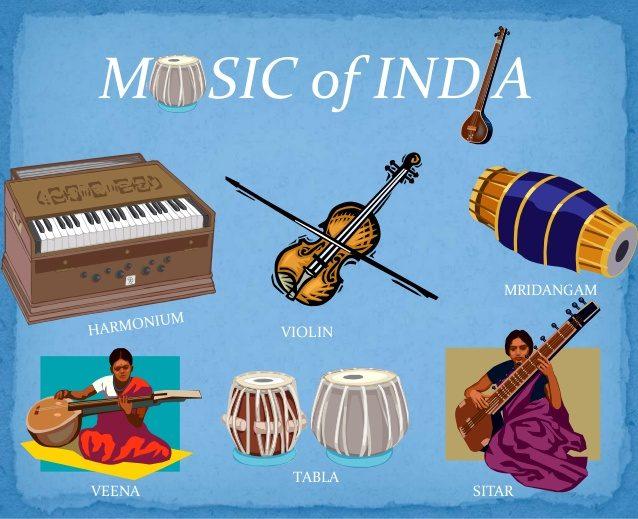Contents
Indian Heritage & Culture: Music
Classical Music
Two main schools of classical music – Hindustani and Carnatic – continue to survive through oral tradition being passed on by teachers to disciples. This has led to the existence of family traditions called gharanas and sampradayas.
Hindustani Music
• Hindustani Sangeet is usually considered to be a mixture of traditional Hindu musical concepts and
Persian performance practice.
• Hindustani music is based on the raga system.
• A raga is a melodic scale, consisting of notes from the basic seven nodes known as sa, re, ga, ma pa, dha,
and ni.
• Khyal and Dhrupad are 2 major types of compositions within the Hindustani genre.
• There are many musical instruments that are associated with Hindustani sangeet. The most famous are
the tabla, sitar, sarangi, santur, and the sarod.
Types of Hindustani Music and its meaning
Dhrupad – Effort from vocal chords and lungs.
Dhamar – Play of Krishna during holy.
Khayal – Delicate, romantic and based on imagination.
Thumri – Romantic religious literature.
Tappa – Quick turn of phase.
Bhajan – Religious devotional songs.
Tarana – Syllables sung together to set a rhythm.
Sabadas – Sikh religious songs.
Qawali – Indo-Muslim repertories of songs in groups.
Ghazal – Independent couplets on love and devotion
Carnatic Music
• Carnatic Sangeet is found in the South Indian states of Kerala, Tamil Nadu, Karnataka, and Andhra
Pradesh.
• Purandardas is considered as the father of Carnatic Music.
• Carnatic music acquired its present form in the 18th century under the “trinity” of Carnatic music;
Thyagaraja, Shamashastri, and Muthuswami composed their famous songs.
• It is also based upon a system of ragam (rag) and thalam (tal).
• Musical instruments veena, violin, mridangam, nadaswaram, and the tavil.
• Kriti is a dominant element.
Types of Carnatic Music and its meaning Ragam
Tanam-Pallavi – Elaborate rhythmic and melodic variation in unmeasured sense.
Kriti-Kirthanai – Most popular type which refers to devotional music laced with poetic beauty.
Varnam – Performed at the beginning of a concert; a completely composed piece.
Padam – Slower tempoed love songs referring to the human yearning for the adored god head.
Javalis – Faster tempoed love songs with direct description of human love.
Tillana – Meaningful phrases are interspersed with variety of meaningless syllables.
Folk Music
- Folk Music like Lavani, Dandiya, Bhagavathi etc.
- Fusion of Classical and Folk music such as Sugama Sangeetha – Thevaram, Keertan etc.,
- Bhajan, Qawwali, Shabad Gana Sangeeth, Haveli Sangeeth etc.,
- Revival of folk music in the wake of globalization.
Modern Music
Different types of music like Rock, Pop etc. its influence on classical and folk
music.
Note:
- Compare and contrast between Hindustani and Carnatic music, classical and suguama sangeeta, folk and classical music etc.
- Personalities and their contribution to music traditions.
- Institution, chief characteristics of music and influence of classic music on contemporary music and vice versa.
Musical Instruments
- Percussion instruments/ Awanad Vadya like Tabala, Mrudangam etc.
- Wind Instruments/ Sushira Vadya like flute, shehanayi.
- String Instruments/ Tata vadya like Sarangi, violin, sitar and veena.
- Solid Instruments/ Gana vadya like manjira, jal tarang etc.
Modern Development in Music
Gandarva Mahavidyala, Sangeet Nataka Academy etc.

